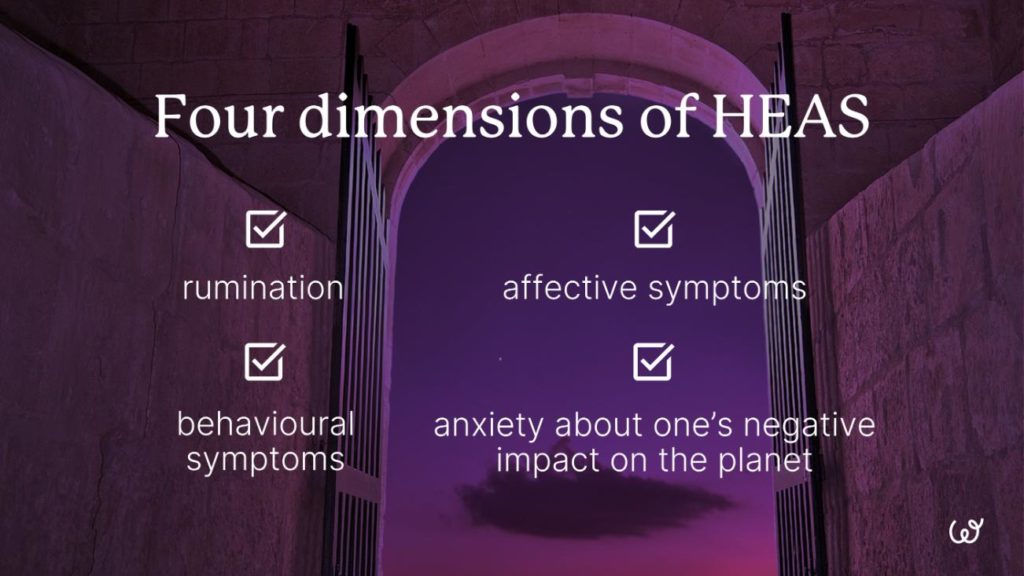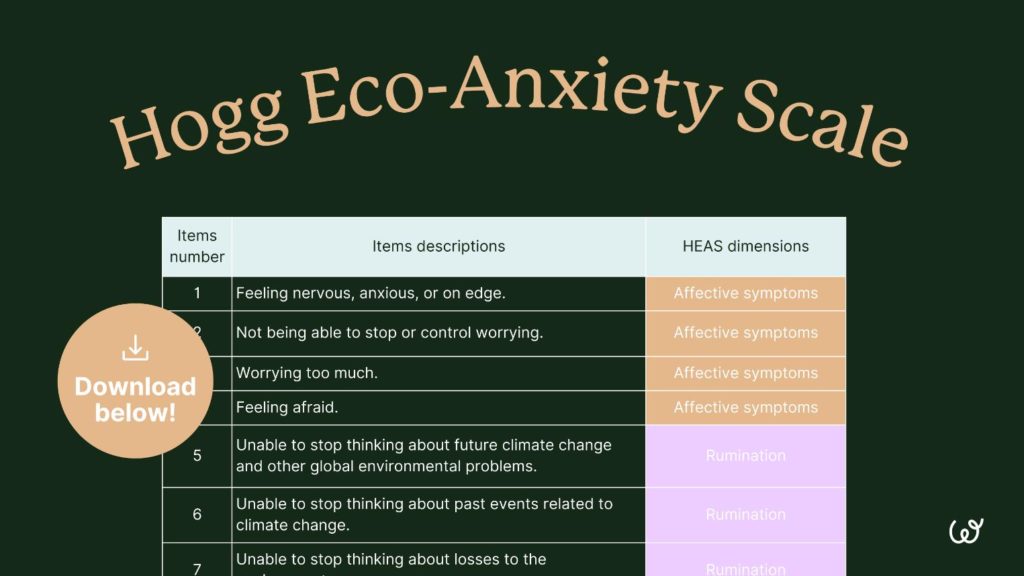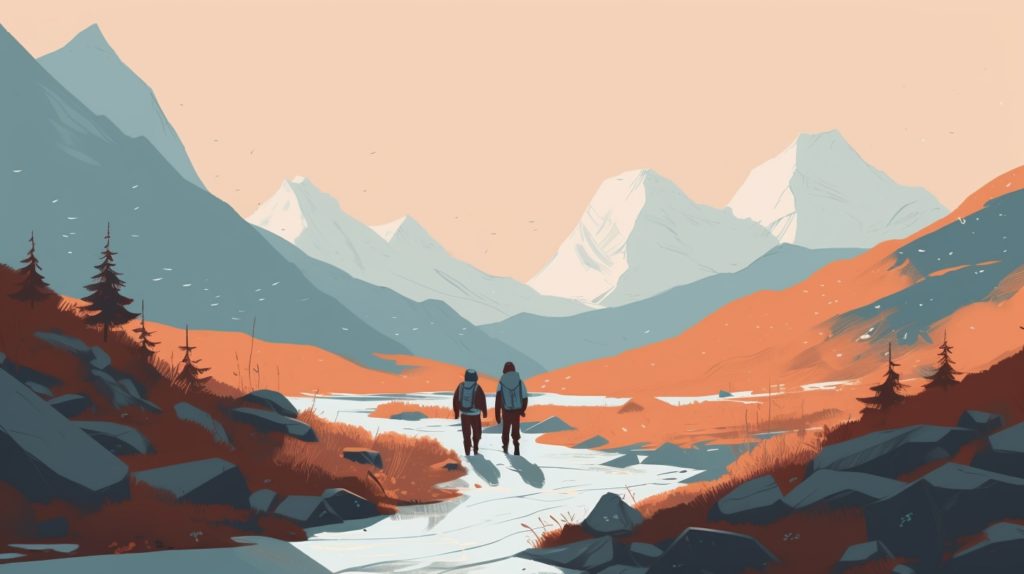As climate change intensifies, so do the waves of reality that cause eco-anxiety; whilst it’s no fun and games, the Hogg eco-anxiety scale is a tool you need to learn if you want to understand more about your climate fears.
So, tell us. What is it all about?
This wild new tool measures an individual’s scale of eco-anxiety by assessing and understanding the psychological effects of climate change. It helps to identify and address eco-anxiety in a supportive manner. If you’re like us, it’s a tool we didn’t know was missing from our lives until we found it!
Often, eco-anxiety can make you feel like a lost cub searching for its family in the wild. While this tool isn’t going to solve all of your problems, it’ll certainly aid in directing your eco-anxiety into action. Here is all you need to know about this tool and its alternatives to assess your level of eco-anxiety.
What is the Hoog eco-anxiety scale (HEAS), and what’s its purpose?
Origin of the Hogg eco-anxiety scale
Originating from the land down under, psychologist Dr. Warren Hogg created his eco-anxiety scale through a multi-study mixed-methods design to crack down on the psychological causes of an individual’s anxiety caused by environmental degradation. It must be noted that it is suitable for those who have experienced eco-anxiety over a period of time, as opposed to a singular emotional response to current weather or climate events.
This study is the first and only validated measure of eco-anxiety that captures anxiety in response to the global environmental crisis, making it distinct from existing scales that specifically measure eco-anxiety.
An eco-anxiety assessment tool created for researchers and clinicians
Its findings support eco-anxiety as a quantifiable psychological experience that is reliably measured and differentiated from mental health outcomes using a 13-item scale. Hallelujah!
Now, it seems a difficult topic to be celebrating, but the scale can also be used in research to study the prevalence and impact of eco-anxiety among different populations. Moreover, it can be employed in clinical practices to assess and address eco-anxiety in therapy sessions. Our previous article, ‘How to deal with eco-anxiety?’, dove into many holistic ways to deal with eco-anxiety. But what if you could accompany these with professional help that is backed by psychological evidence proven to aid coping strategies in the face of environmental stressors?
The objectives of the eco-anxiety assessment questionnaire
Its purpose is to quantify the extent of eco-anxiety experienced by individuals, providing insights into their emotional responses to environmental concerns like rising temperatures and habitat loss, to name a few. Hopefully, by understanding these feelings, individuals and professionals can work towards managing and coping with eco-anxiety effectively.
The scale typically consists of a series of questions or statements designed to assess various aspects of eco-anxiety. It can include questions about concerns regarding climate change, feelings of powerlessness in addressing nature-related events, worry about the planet’s future, or emotional responses to environmental news.
How does the Hogg eco-anxiety scale scoring system work?
The four dimensions of the eco-anxiety scale
- affective symptoms;
- rumination;
- behavioural symptoms;
- anxiety about one’s negative impact on the planet.

The 13 items building the scale of eco-anxiety
- Feeling nervous, anxious, or on edge.
- Not being able to stop or control worrying.
- Worrying too much.
- Feeling afraid.
- Unable to stop thinking about future climate change and other global environmental problems.
- Unable to stop thinking about past events related to climate change.
- Unable to stop thinking about losses to the environment.
- Difficulty sleeping.
- Difficulty enjoying social situations with family and friends.
- Difficulty working and/or studying.
- Feeling anxious about the impact of your personal behaviour on the earth.
- Feeling anxious about your personal responsibility to help address environmental problems.
- Feeling anxious that your personal behaviours will do little to help fix the problem.
The scoring system of the HEAS
Typically, respondents answer each of the 13 questions or statements based on their level of agreement or disagreement, often using a scale ranging from ‘strongly disagree’ to ‘strongly agree’. Each score is then tallied to determine the individual’s overall level of eco-anxiety.
Originally, Hogg used a multiverse methodical approach that gains insight into participants’ experiences of eco-anxiety through an initial 7-item scale to capture negative affective symptoms related to eco-anxiety. The reported symptomatology of eco-anxiety appears remarkably similar to symptoms of Generalised Anxiety Disorder (GAD). This initial measure was modeled on the GAD scale.
Now, we’re all fans of a quiz night, so who’s up for scoring themselves against Hogg’s eco-anxiety scale?
Eco-anxiety scale table and PDF to download
Here is a visual aid to help you better understand the Hogg eco-anxiety scale, including the 13 items and its four dimensions. Feel free to download it so you can always refer to it!

How can you measure your eco-anxiety at a personal level?
The first step to measuring your eco-anxiety is understanding its symptoms. Don’t fret, we’ve made this part easy by undressing the top eco-anxiety symptoms in our recent article: ‘11 Eco-Anxiety Symptoms | Learn What They Are & Turn Them Into Action’.
Next, we recommend connecting with individuals who understand your struggles. This can offer reassurance amid eco-anxiety challenges – the calm within the storm, shall we say. Whether it’s in a professional setting or more casually, opening up about your eco-anxiety experiences can alleviate some of the burdensome stressors weighing on your mind.
How to deal with eco-anxiety in your daily lives?
Addressing climate change is no small feat—it’s a challenge that requires collective effort. While this reality may seem daunting, it serves as a gentle nudge to concentrate on what you can personally influence rather than dwelling on what you cannot.
Crucial insight lies in taking proactive steps to address both environmental issues and your mental health. Incorporating sustainable habits that are mindful of energy use, waste, and consumerism is a great way to start.
It’s no secret that nature plays a crucial role in improving your mental fitness, too. In fact, 91% of adults said that natural spaces have a positive impact on mental health and well-being! So, why not challenge yourself to get out in nature and simply feel the sun’s beams kiss your cheeks instead of the artificial light source from our screens?
What if we told you that by investing a small amount of time each day through nature-based learning, you can create a big impact with the Wildya community. It’s simple: instead of theory, we focus on action. We provide you with courses that tackle all of these symptoms and daily actions to ensure you take your life back.
So, how did you do? Addressing your fears can be daunting, but knowing you are playing a part in fostering awareness, support, and effective coping strategies for those experiencing eco-anxiety is a great feeling.
By assessing various dimensions of environmental concern, this scale of eco-anxiety provides insights into emotional responses. It then facilitates research and clinical interventions to address and cope with eco-anxiety effectively.
Not only this, but the Hogg eco-anxiety scale contributes to research by providing quantitative data on the prevalence and severity of eco-anxiety, informing public policy and advocacy efforts aimed at addressing environmental challenges. Go you!


